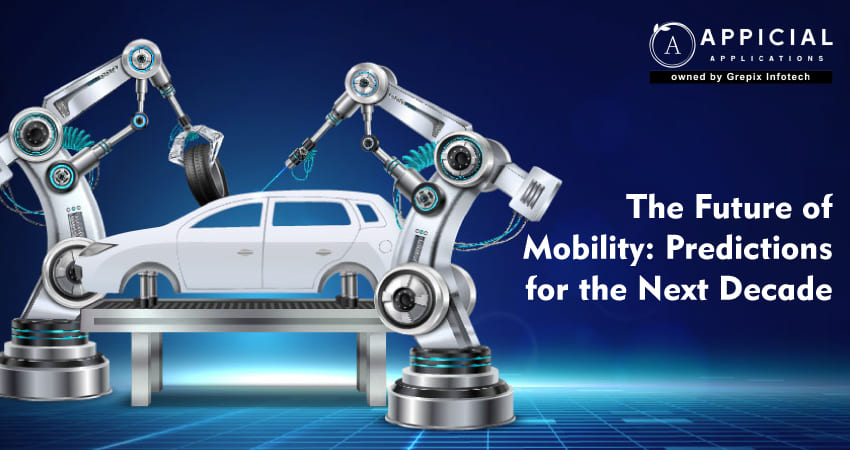
The Future of Mobility: Predictions for the Next Decade
The landscape of mobility is undergoing a seismic shift, driven by technological advancements, environmental concerns, and changing consumer preferences. As we stand on the cusp of a new era, the next decade promises transformative changes that redefine how we move people and goods. From electric vehicles becoming the norm to the advent of autonomous driving, the future of mobility is set to be more connected, sustainable, and efficient. This article explores the key trends and predictions that will shape mobility in the next ten years.
The next decade in mobility is poised for transformative advancements, driven by evolving technologies, environmental imperatives, and shifts in consumer behavior. This era will see electric vehicles (EVs) become mainstream, supported by innovations like solid-state batteries and integration with the energy grid through vehicle-to-grid (V2G) technology. Autonomous vehicles (AVs) are also expected to advance, with regulatory and ethical frameworks being key to their adoption. Additionally, the rise of mobility as a service (MaaS) and micromobility will redefine urban transport, making it more accessible and efficient. Smart city initiatives will enhance urban mobility through real-time traffic management and infrastructure improvements. However, the sector faces challenges such as the need for significant infrastructure investment, data privacy concerns, and ensuring equitable access to these new technologies. Overall, the mobility landscape is shifting towards a more connected, sustainable, and efficient future.
Electric Vehicles (EVs) Take Center Stage
Electric vehicles have moved beyond being a niche market to becoming a central focus of the automotive industry. Governments worldwide are setting ambitious targets to phase out internal combustion engines, with countries like Norway aiming for 100% electric car sales by 2025. The next decade will witness a significant acceleration in EV adoption, fueled by advancements in battery technology and increased affordability.
Battery technology is at the heart of the EV revolution. Solid-state batteries, which offer higher energy density and faster charging times, are expected to reach commercial viability. Companies like Toyota and QuantumScape are investing heavily in this technology, which could double the range of electric cars and reduce charging times to minutes rather than hours. Additionally, the recycling and second-life use of batteries will become critical components of the EV ecosystem, addressing environmental concerns associated with battery disposal.
The integration of EVs into the energy grid will also play a crucial role. Vehicle-to-grid (V2G) technology allows electric cars to feed energy back into the grid during peak demand, turning them into mobile energy storage units. This not only provides an additional revenue stream for EV owners but also enhances grid stability. Governments and utility companies will likely incentivize V2G participation, further intertwining transportation with energy infrastructure.
The Rise of Autonomous Vehicles (AVs)
Autonomous vehicles have long been a topic of fascination and skepticism. However, recent advancements in artificial intelligence, machine learning, and sensor technology have brought us closer to realizing fully self-driving cars. Companies like Waymo, Tesla, and Cruise are conducting extensive testing, and it's anticipated that Level 4 autonomy (high automation) will become more prevalent in controlled environments within the next decade.
Regulatory frameworks will play a pivotal role in the deployment of AVs. Governments will need to establish comprehensive guidelines addressing safety standards, liability in the event of accidents, and cybersecurity measures to protect against hacking. Public acceptance will also hinge on addressing ethical considerations, such as how autonomous systems make life-and-death decisions in critical situations.
The widespread adoption of AVs has the potential to reshape urban landscapes and economies. With vehicles capable of operating continuously without human intervention, we may see a decline in personal car ownership in favor of shared autonomous fleets. This shift could reduce the number of vehicles on the road, alleviate traffic congestion, and open up urban spaces currently dedicated to parking.
Shared Mobility and Micromobility Expansion
Mobility as a service (MaaS) is gaining traction, emphasizing shared transportation solutions over private ownership. Ride-sharing platforms like Uber and Lyft have already disrupted traditional taxi services, and their evolution will continue to influence urban mobility. The integration of autonomous vehicles into these platforms could reduce operational costs and make ride-sharing more affordable and accessible.
Micromobility options, such as electric scooters and bikes, are becoming integral parts of urban transportation networks. These solutions offer convenient and environmentally friendly alternatives for short-distance travel. Cities will likely invest in infrastructure to support micromobility, including dedicated lanes and parking zones, to enhance safety and encourage adoption.
Public transportation systems will increasingly integrate with shared mobility services to provide seamless end-to-end journeys. Mobile applications that allow users to plan and pay for multi-modal trips will become standard, improving the convenience and efficiency of public transit.
Smart Cities and Urban Mobility Solutions
As urban populations grow, cities face the challenge of managing increased demand on transportation networks. Smart city initiatives aim to leverage technology to improve urban living, and mobility is a key focus area. The deployment of Internet of Things (IoT) devices and advanced analytics will enable real-time traffic management, reducing congestion and improving air quality.
Intelligent transportation systems (ITS) will utilize data from connected vehicles and infrastructure to optimize traffic signals, reroute traffic during incidents, and provide real-time information to travelers. This proactive approach to traffic management can significantly reduce travel times and enhance road safety.
Urban planning will also evolve to support new mobility paradigms. Concepts like transit-oriented development (TOD) encourage the creation of high-density, mixed-use communities centered around public transportation hubs. By reducing the reliance on private vehicles, cities can create more livable, sustainable environments.
Also Read: Integrating Payment Solutions into Taxi Apps
Emphasis on Sustainable Mobility
Environmental concerns are driving a global push toward sustainability in all sectors, including transportation. The next decade will see a concerted effort to reduce the carbon footprint of mobility. Beyond the electrification of vehicles, alternative fuels like hydrogen and biofuels will play a role, particularly in sectors where electrification is challenging, such as aviation and heavy-duty trucking.
Governments will implement policies to encourage public transportation, walking, and cycling. Investments in infrastructure, such as bike lanes and pedestrian zones, will make these modes of transport safer and more appealing. Educational campaigns and incentives can also shift public attitudes towards more sustainable travel habits.
Corporate fleets will adopt greener practices as part of broader environmental, social, and governance (ESG) commitments. Companies may transition to electric delivery vehicles and optimize logistics to reduce emissions. Consumer demand for environmentally responsible services will further drive this shift.
The Advent of Air Mobility
Advancements in technology are bringing the concept of urban air mobility (UAM) closer to reality. Electric vertical takeoff and landing (eVTOL) aircraft, often referred to as flying cars, are being developed by companies like Joby Aviation and Volocopter. These vehicles promise to alleviate ground traffic congestion by opening the airspace for short-distance urban travel.
Drone delivery services are also set to expand, with companies like Amazon and Wing conducting pilot programs. Regulatory bodies are working to establish guidelines for the safe integration of drones into airspace, addressing concerns around noise pollution, privacy, and air traffic control.
While air mobility offers exciting possibilities, significant challenges remain. Infrastructure such as vertiports, air traffic management systems, and safety protocols need to be developed. Public acceptance will depend on demonstrating the reliability and safety of these new modes of transport.
Connectivity and Data in Mobility
Connectivity is the backbone of future mobility solutions. The rollout of 5G networks provides the high-speed, low-latency communication required for advanced applications like autonomous driving and real-time traffic management. Vehicle-to-everything (V2X) communication enables vehicles to interact with each other and with infrastructure, enhancing safety and efficiency.
Data generated by connected vehicles offers valuable insights but raises concerns about privacy and security. Robust cybersecurity measures will be essential to protect against threats that could compromise vehicle systems or personal data. Regulations like the General Data Protection Regulation (GDPR) in Europe set standards for data handling, and similar frameworks will likely be adopted globally.
The use of big data analytics and artificial intelligence will enable predictive maintenance, personalized user experiences, and optimized routing. However, stakeholders must navigate the ethical considerations of data usage, ensuring transparency and user consent.
Challenges and Considerations
Despite the promising developments, several challenges could impact the trajectory of mobility transformation. Infrastructure investment is crucial; electric and autonomous vehicles require charging stations, sensors, and communication networks. Coordinated efforts between governments, private companies, and communities are necessary to build this infrastructure.
Equity and access are significant concerns. There is a risk that advanced mobility solutions may not be accessible to all segments of the population, exacerbating existing social inequalities. Policies and initiatives must ensure that rural areas and underserved communities benefit from improvements in mobility.
The shift towards automation may lead to job displacement, particularly in trucking and taxi services. Workforce retraining and social support systems will be needed to mitigate the economic impact on affected workers. Additionally, new job opportunities will emerge in technology development, infrastructure maintenance, and mobility services.
Conclusion
The mobility landscape is poised for a remarkable transformation over the next decade, propelled by innovations in electric and autonomous vehicles, shared mobility services, and the development of smart urban infrastructure. As these technologies mature, they will not only reshape how we travel but also have the potential to significantly impact urban planning, environmental sustainability, and social dynamics.
Appicial Applications a leading taxi app development company, that operates in the realm of mobility solutions, the opportunities are vast. The shift towards electric vehicles and the integration of vehicle-to-grid technologies offer new avenues for developing smarter, more efficient transportation systems. Autonomous driving technology continues to progress, promising to enhance safety and optimize traffic flows, potentially revolutionizing public transit and logistics through automated fleets.
However, as the industry evolves, it will also face significant challenges that require innovative solutions and proactive governance. Data privacy, cybersecurity, equitable access, and the need for substantial infrastructure investments must be addressed to ensure these technologies deliver their full potential benefits. Additionally, the transition may disrupt existing employment landscapes, necessitating strategies for workforce adaptation and skills development.
We must stay at the forefront of technological advancements, regulatory changes, and market trends to capitalize on these shifts. By fostering collaboration with governments, other businesses, and communities, they can help drive the adoption of sustainable mobility solutions that are accessible to all. As we look to a future where mobility is interconnected, electrified, and automated, the focus must also remain on creating inclusive and sustainable systems that enhance the quality of life for people around the globe. This decade of innovation will require a collective effort to navigate the complexities of the new mobility paradigm, ensuring that technology serves as a bridge to a more sustainable, efficient, and inclusive world.
Looking out to start your own venture like Uber? Try out our HireMe Uber Clone, the easiest way to kick-start your taxi business.




